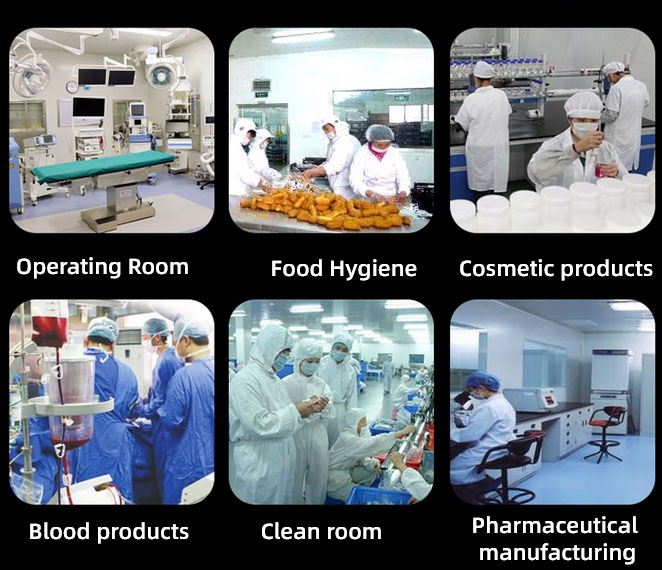Particle counters are instruments used to measure and count the number of particles in a given environment, such as air or liquids. These devices are widely used in various industries and applications to monitor and assess the cleanliness and quality of the air or fluids. Particle counters are critical tools in environments where the presence of particles can have a significant impact, such as in cleanrooms, healthcare facilities, pharmaceutical manufacturing, environmental monitoring, and research laboratories. In this paper, We will show you what the particle counter can be used for.
Applications
- Air Quality Monitoring: Particle counters are commonly used to assess air quality and pollution levels. They can measure the concentration of airborne particles, such as dust, pollen, soot, and fine particulate matter (PM2.5 and PM10), which are important indicators of air pollution and can have significant health implications.
- Cleanroom Validation: In industries like pharmaceuticals, electronics manufacturing, and semiconductor production, maintaining a clean environment is critical. Particle counters are used to verify and validate the cleanliness of cleanrooms and controlled environments by counting and sizing particles to ensure they meet specific cleanliness standards.
- Indoor Air Quality Assessment: Particle counters can help assess indoor air quality in homes, offices, and public buildings. They are used to monitor indoor air for allergens, pollutants, and contaminants.
- HVAC System Maintenance: Heating, ventilation, and air conditioning (HVAC) systems can harbor and distribute particles throughout a building. Particle counters are used to evaluate the effectiveness of HVAC filters and the overall air quality in buildings.
- Environmental Monitoring: Environmental scientists and researchers use particle counters to study particle pollution in outdoor environments, such as monitoring dust storms, assessing the impact of wildfires, and studying the dispersion of pollutants in the atmosphere.
- Aerosol Research: In scientific research, particle counters are used to study aerosols and particulate matter in the atmosphere, including their size distribution, concentration, and composition. This research can have applications in climate science, atmospheric studies, and public health.
- Liquid Quality Control: Particle counters are used in industries like pharmaceuticals, food and beverage, and water treatment to monitor the quality of liquids for the presence of particulate matter, contaminants, and impurities.
- Medical and Healthcare: Particle counters are used in medical and healthcare settings to assess the air quality in operating rooms, laboratories, and clean areas where maintaining a sterile environment is critical.
- Oil and Gas Industry: In the oil and gas industry, particle counters are used to monitor and control the cleanliness of hydraulic fluids, lubricating oils, and other liquids to ensure the proper operation of machinery and equipment.
- Research and Development: Particle counters are used in various scientific and industrial research applications to study particle behavior, develop new materials, and understand the dynamics of particulate systems.

Precaution
Pay attention to the following points in daily use and maintenance:
- 1. when the inlet pipe is covered or blocked, do not start the counter.
- 2. should be used in a clean environment to prevent damage to the laser sensor
- 3. prohibit the extraction of gas containing oil, corrosive substances, and do not measure the possible reaction of the gas mixture (such as hydrogen and oxygen). These gases may also cause an explosion in the counter. Measurement of these gases needs to contact the manufacturer for more information.
- 4. Do not sample compressed air without high pressure relief equipment (e.g. high-pressure diffusers), all counters are designed to operate in one atmosphere. The working position of the instrument and the sampling port should be in the same air pressure and the same temperature and humidity environment to ensure that the instrument works properly.
- 5. Water, solutions or other liquids should not enter the sensor through the inlet tube.
- 6. The particle counter is mainly used to test the clean room environment, when the measurement of the place of loose particles of material, dust sources, spray place, must be kept at least 12 inches away from the inlet pipe. To avoid the above particles and liquid contamination of the sensor and piping.
- 7. sampling, to avoid sampling from the counter itself out of the gas-contaminated gas.
- 8. in the connection of an external printer or connected to the external temperature and humidity sensor, you need to turn off the counter; when the print operation, the printer must have print paper, otherwise it will damage the print head.
- 9. When handling the counter should be carried gently and put down lightly, with less vibration and shock. Especially for the desktop particle counter, be more careful so as not to damage the internal components.
Particle counters are valuable tools for ensuring and maintaining the quality of air, liquids, and controlled environments in a wide range of industries and applications. They help identify and mitigate potential health risks, production issues, and environmental concerns associated with particle contamination. sisco shop offers a variety of particle counters for you to choose from, if you are interested, please click to buy.

